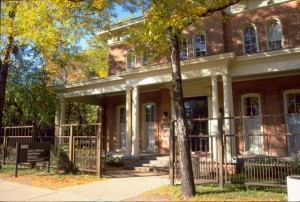Last night, I was proud to be inducted on to the board of directors for the Pleasant Home Foundation. Located in Oak Park, Pleasant Home is a grand Prairie-Style home designed by George Maher, a contemporary of Frank Lloyd Wright. The Foundation is responsible for the restoration of the building and its operation as an historic house museum. Most visitors to Oak Park who have an eye for architecture naturally gravitate toward ol’ FLW, and understandably so. But it’s important to remember that the village is home to much more than Wright’s work. Indeed, Pleasant Home is a local landmark, was listed on the National Register in 1972, and became a National Historic Landmark in 1996.

Pleasant Home
For me, there are some interesting parallels between this new house museum with which I’m associated and with the one where I work. Sure, Hull House predates Pleasant Home by about 40 years but both, I think, do a good job of illustrating the “embodied history” that give a building its significance over time. In Hull House’s case that embodied history came from the vision and work of Jane Addams and the other settlement reformers. Pleasant Home, as sort of proto-Prairie writ large really provides a grounding and foundation for that architectural movement and makes it easier to read its development over time. Both properties are local landmarks, National Register-listed, and National Historic Landmarks. Both are associated with larger governmental organizations – the University of Illinois in the case of Hull House and the Park District of Oak Park for Pleasant Home. Both seek to interpret the lives of those who lived there, and both recognize that that’s not enough to keep people coming back.
In a recent entry on his excellent blog, Vince Michael says that house museums typically make no more than 20 or 25 percent of their operating costs through admissions and tours. In the case of Hull House, we don’t charge admission and with tours we ask for a non-mandatory donation. We’re blessed by the fact that the University covers basic operating expenses: keeping the lights on, providing basic cyclical maintenance, and making sure the staff gets paid. But beyond that, we have raise any other funds we need. And that’s pretty much for anything else: exhibits, programs, renovations, etc. I’ve only been on board for about 12 hours at this point, so I can’t claim to know the financial picture at Pleasant Home, but I wouldn’t be surprised to learn that it’s much the same.
There’s a great push these days to demonstrate the environmental sustainability of historic buildings, but historic house museums are a good example of the fact that historic sites have to be economically sustainable. Vince says, “Creative programming and appropriate income-generation are necessary for all sites.” That’s 100% correct. Whether the income’s generated by admission or by donation, the more people through the door, the further along an historic site will be on the path to sustainability. And you can get a lot of people through the door by having a diverse and engaging suite of programming. I think we do that pretty well here at the Hull House museum, although – yeah – I’m biased. And we think its important that the programming be faithful to the significance of the site. Unasked but always subconsciously present whenever planning an event is the question, “Is this the type of event that Jane Addams would have hosted.” I like to think that we get it right for the most part. In its way, Pleasant Home does it well too. The Farsons (who built the house) had a reputation for throwing large and lavish parties. Today, the house earns income from rental for use as a venue for weddings, parties, etc. The house is also used as a space for lectures on architecture, history, and art. The local historical society has offices and exhibit space on the second floor. I haven’t fleshed out the idea fully yet, but I think there also might be a real opportunity to use the house as an “architectural history lab” and use the design, features, systems, etc. of the house to help explain/provide context for the era in which the house was used. (i.e., being led on an examination of the servants’ spaces to learn more about changes in domestic life over time, looking at the building’s electrical features and learning about what it was like when electrical lighting was the cutting edge.) We do something similar here at the Hull House Museum in our ‘Architectural Encounters’ exhibits and it seems to be working well.
My least favorite kind of historic sites are the ones that seem to exist only because they’re old and offer no other context. If, like me, you’re a sucker and pay the admission anyway, all you find are dusty old rooms that feel more like your grandmother’s little-used guestroom rather than a piece of history come to life.
I’m happy, proud, and energized to be associated with two historic sites that aren’t that at all.
History should lean forward.

